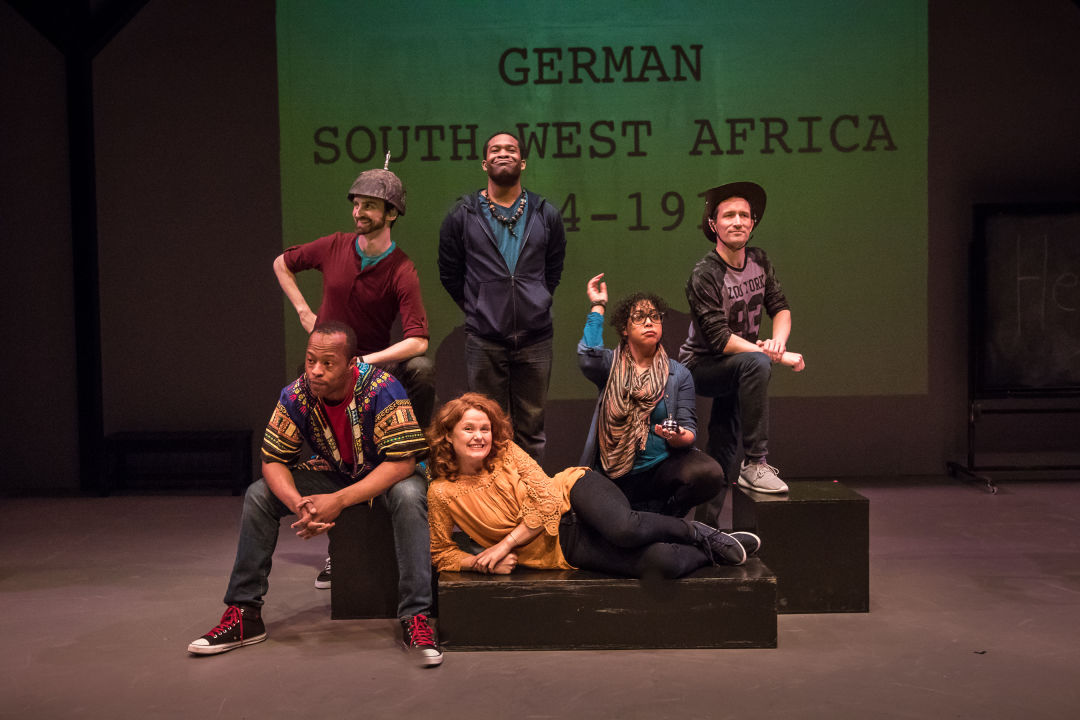Why Are Portland Millennials So Theater-Averse?

Did Artist Rep's We Are Proud To Present a Presentation About the Herero of Namibia, Formerly Known As South West Africa, From The German Sudwestafrika, Between the Years 1884-1915 reach the right audience?
Image: Owen Carey
Have you ever been to a local theater production and taken in your fellow audience members? It’s not exactly the same crowd spotted twerking at Holocene on a Friday night. As an apparently prototypical millennial, I will admit I’ve only been to one local play in the five years I’ve lived in Portland. In comparison, I’ve probably attended about 40 movies, and I average a solo Netflix and chill about 3.5 times a week. But is it just me?
“Our single-ticket audience average age is 42 years old at Portland Center Stage,” says Cynthia Fuhrman, Portland Center Stage’s chief operating officer. “But the subscribers who are coming back multiple times are a bit older.” In 2009, the smaller Third Rail Repertory conducted a survey of their audience members and found that their regulars were affluent white women, 55 years old or older. Similarly, Nicole Lane of Artist’s Repertory Theatre says a 2013 audience survey “revealed that more than 50 percent of the audience respondents were in the 55–74 age category.”
Portland theaters, both big and small, are mostly attracting older audiences. So why aren’t younger audiences engaged?
Sure, some local theater companies–Action/Adventure Theatre springs to mind–already skew toward a younger demographic, in part thanks to more experimental formulas. (Heavy doses of improv, here’s looking at you). But the vast majority of Portland theatergoers are not people like me.
“I think this is the truth: younger demographics are people paying off student loans or buying their first home; they’re having kids and jobs. They’re busy,” says Third Rail company member Maureen Porter. “There are also components like price. We have to ask ourselves: have we created content or fiscal accessibility so that there is value for these people to commit their time and money?”
Josh Weinstein, a 27-year-old actor with Artists Rep—the only resident actor from a total of 23 who's under 30—agrees the kind of shows being presented may be part of the problem. “There’s that feeling of being a fossil,” he says. “I do worry that there will come a time where this next generation of theatergoers will decide it’s not worth it, unless we change the paradigm. I think we need to tell the story in a way that’s more accessible.”
Weinstein worries that a lack of change in the vernacular, the content (modernizing plays through culturally diverse storytelling or through technology), and even the actors (recruiting younger or ethnically diverse actors) might leave Portland plays frozen in a format that won’t appeal to changing, contemporary crowds. After all, Portland’s population is only getting younger.
“There was a show [We Are Proud To Present a Presentation About the Herero of Namibia, Formerly Known As South West Africa, From The German Sudwestafrika, Between the Years 1884-1915] about race that we just did that was written by a young African-American writer from Brooklyn and it was written in a very young vernacular—very tightly written, very casual—and there was a gap in understanding for what was mostly an older, middle-class white audience,” says Weinstein. “The ageism suggested by that show left a raw taste in my mouth.”
So to the question: Are Portland theater companies doing anything about it? Actually, they’re doing quite a bit.
Big theater companies like Portland Center Stage have recently taken steps in the light of the Wallace Foundation’s Building Audiences for Sustainability arts initiative, passed in April 2015. This initiative is dedicated to encouraging new, diverse audiences (e.g. youth) as well as retaining the existing older audience through increased audience engagement.
“Under the Wallace initiative, we were able to do some focus groups and we were able to get some insight from the 25-to-40-year-old audience range to see what content they’re interested in,” says PCS spokesperson Claudie Jean Fisher. “We’ve lowered tickets to $25 and we offer premium tickets to students and people under 30. Part of the problem is price and the perception of price: people think theater is expensive.”
Third Rail, though a much smaller company with less funding, is also making an effort to reach out to younger crowds. A few years ago, they added a mentorship program, which Porter nicknames “a gateway drug into theater.” Essentially, it allows emerging playwrights to produce new work in conjunction with the company. There is also a student subscription sponsorship program, which connects patrons with students and supplies them with show information and merchandise. And those under age 25 can get cheap rush tickets for seats that aren’t filled right before showtime.
Efforts like these have already had effects. “Will it ever be 50/50 older and younger? Probably not,” says Porter. “But recently, I saw a crowd at The New Electric Ballroom that looked like it was 70 percent under 40, and afterwards we had a discussion with the audience about how the audience felt. We can’t do this overnight, but we’re continuing to interact with younger theatergoers to make a change.”
